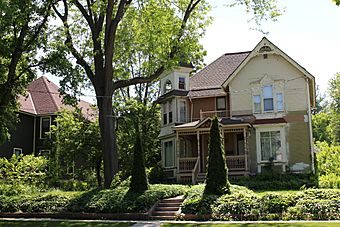Lodi Street-Prairie Street Historic District facts for kids
Quick facts for kids |
|
|
Lodi Street-Prairie Street Historic District
|
|

A portion of the district.
|
|
| Location | Roughly Prairie St. from 2nd St. to Mill St. Lodi, Wisconsin |
|---|---|
| NRHP reference No. | 00000735 |
| Added to NRHP | June 22, 2000 |
The Lodi Street-Prairie Street Historic District is a special neighborhood in Lodi, Wisconsin. It's a place where many old and important buildings are protected. This district shows us what Lodi looked like a long time ago.
Contents
Discovering the Lodi Historic District
This historic district is a residential area. It means people live in these old houses. The district also includes some buildings that were once used for businesses. It's like a living museum of architecture.
What Makes This District Special?
The Lodi Street-Prairie Street Historic District is special because of its old buildings. These buildings show different styles of architecture. They were built over many years, from the mid-1800s to the early 1900s.
A Look at the Old Buildings
The district has several interesting buildings. Each one tells a story about its time.
- The McCloud House was built in 1855. It's an example of the Italianate style. This style often has tall, narrow windows and decorative brackets under the roof.
- The Hinds House dates back to 1874. It shows the Greek Revival style. This style often looks like ancient Greek temples, with columns and simple, strong shapes.
- The Clements House hotel is another old building. It uses a commercial vernacular style. This means it was built for business and used common building methods of its time.
- The Seville House was built in 1897. It's a beautiful example of the Queen Anne style. This style is known for its towers, turrets, and decorative details.
- The Posta Bungalow was built later, in 1915. A bungalow is a smaller house, often with a wide porch and a low-pitched roof.
Why Are These Buildings Protected?
The Lodi Street-Prairie Street Historic District was added to the State and the National Register of Historic Places in 2000. This means the buildings are recognized as important. They are part of the history of Wisconsin and the United States. Being on this list helps protect them for future generations.

